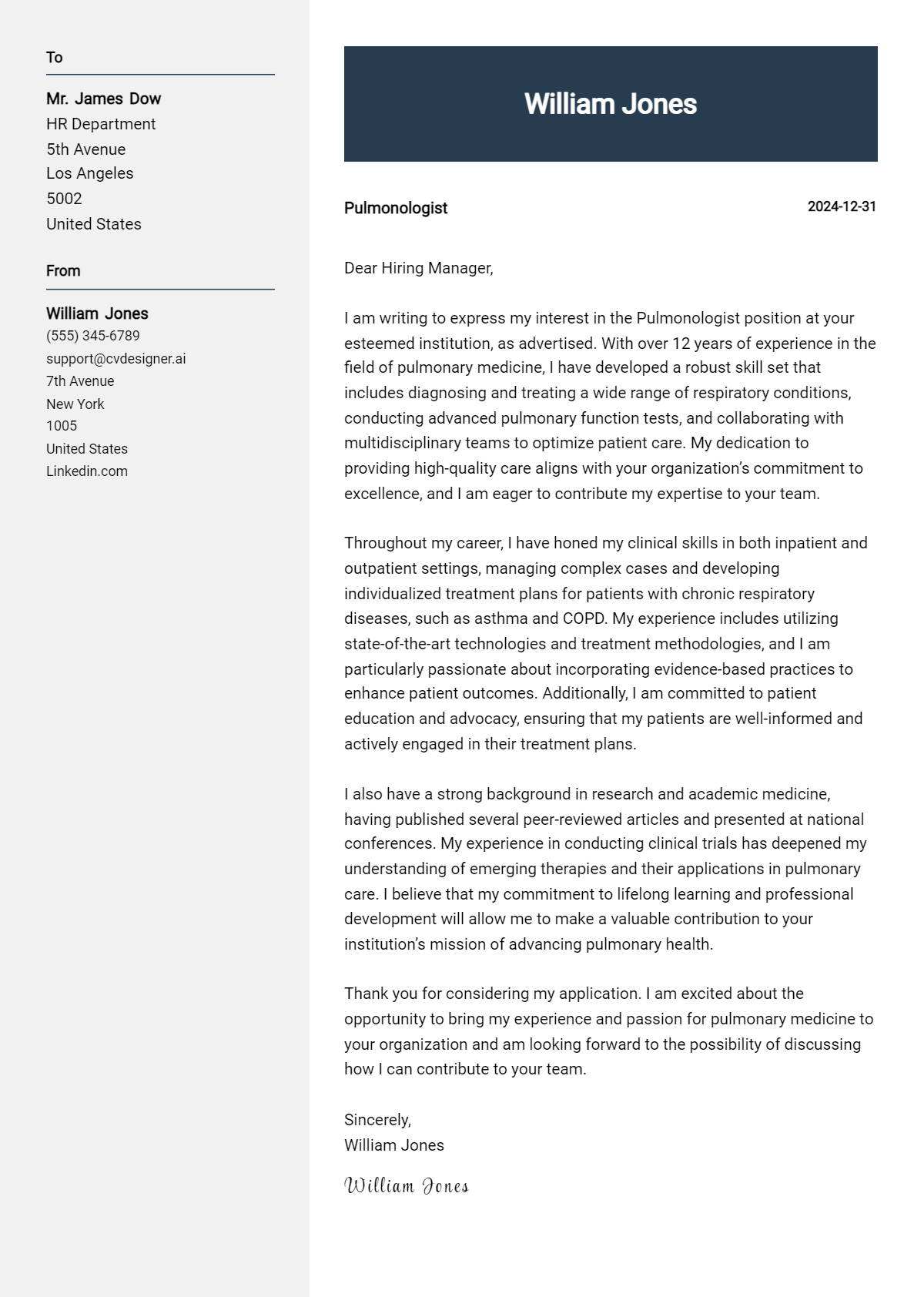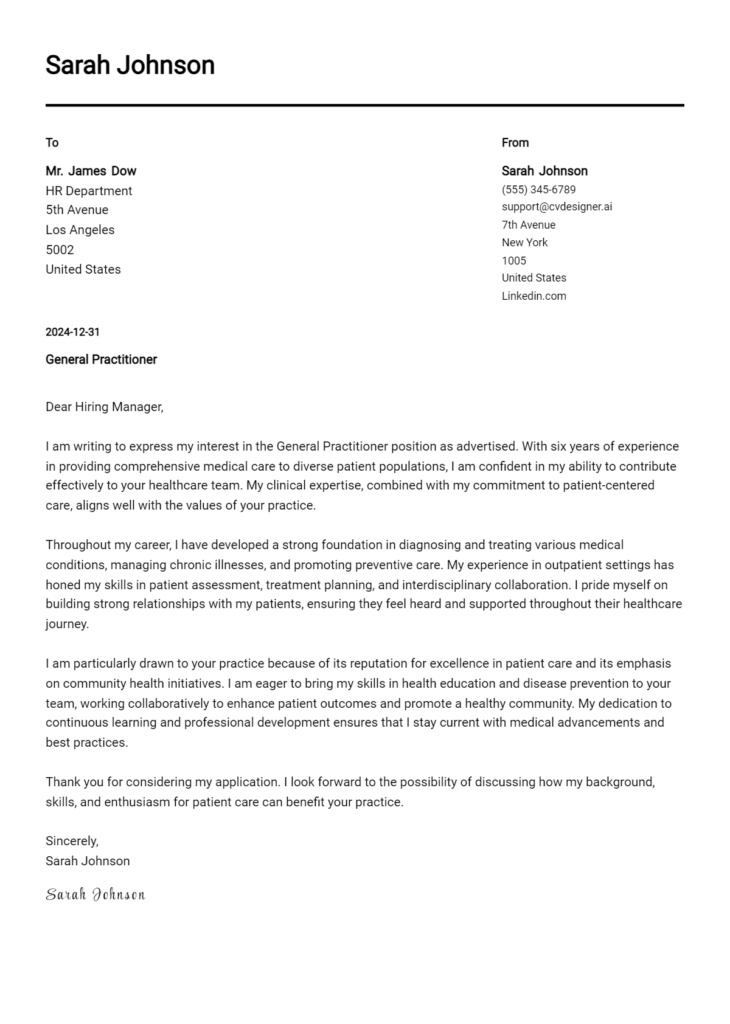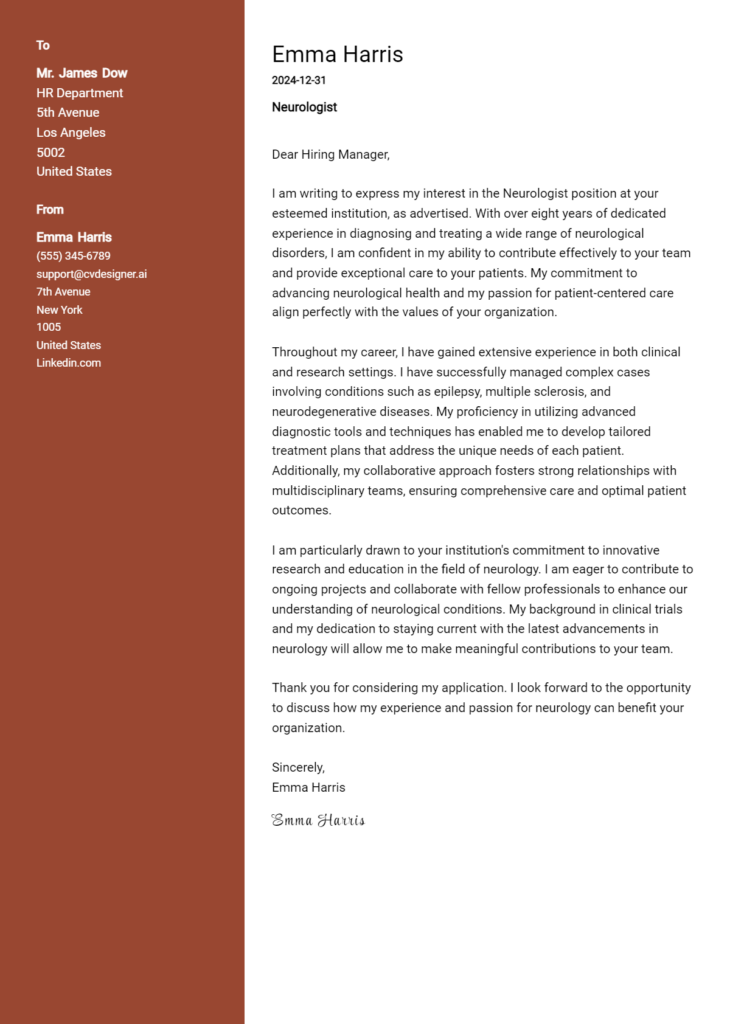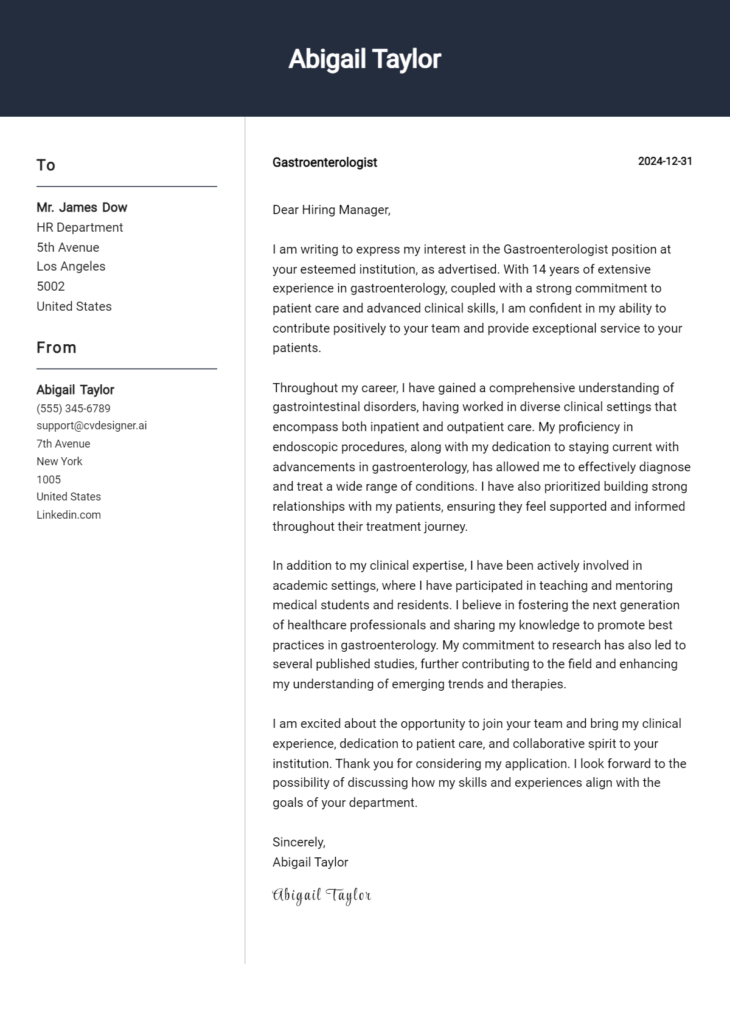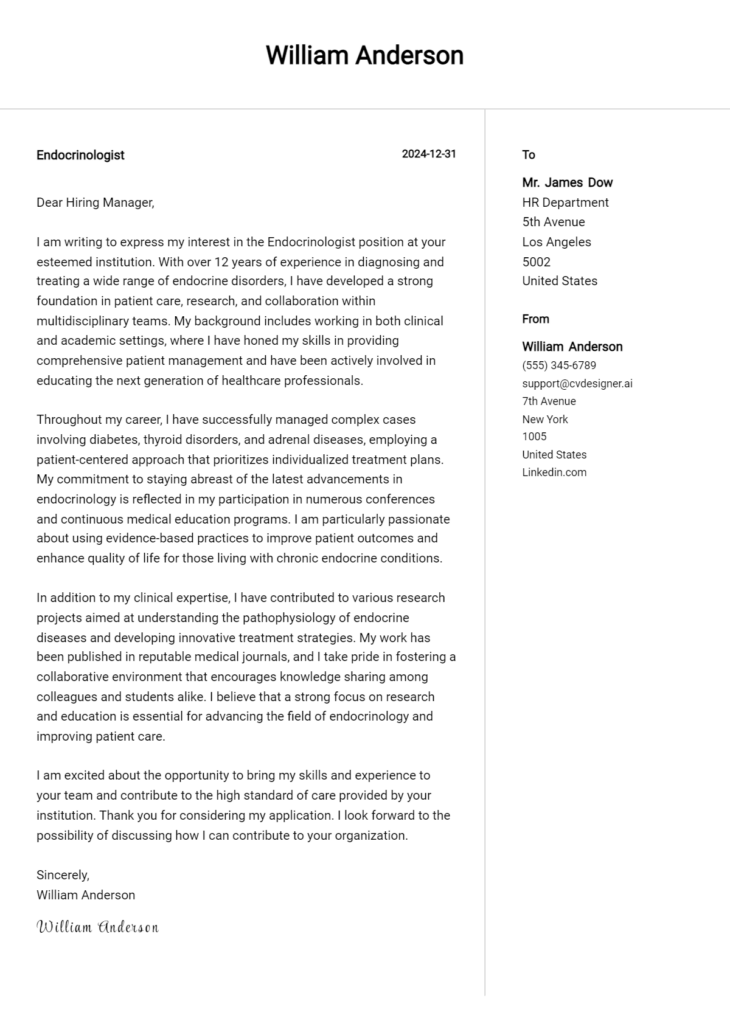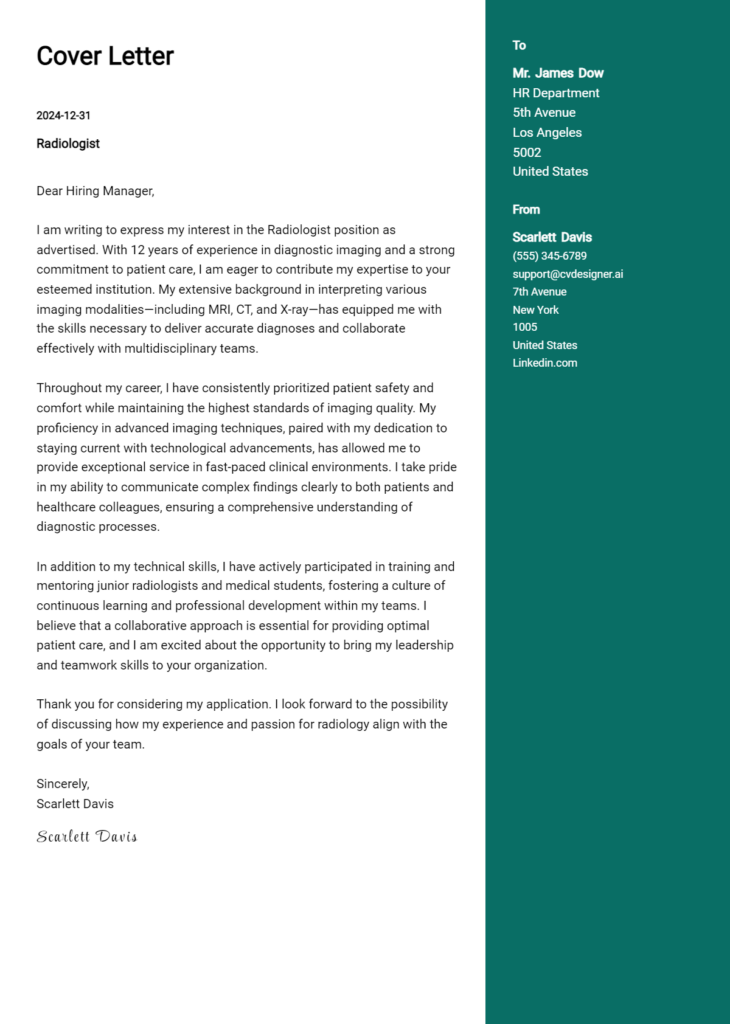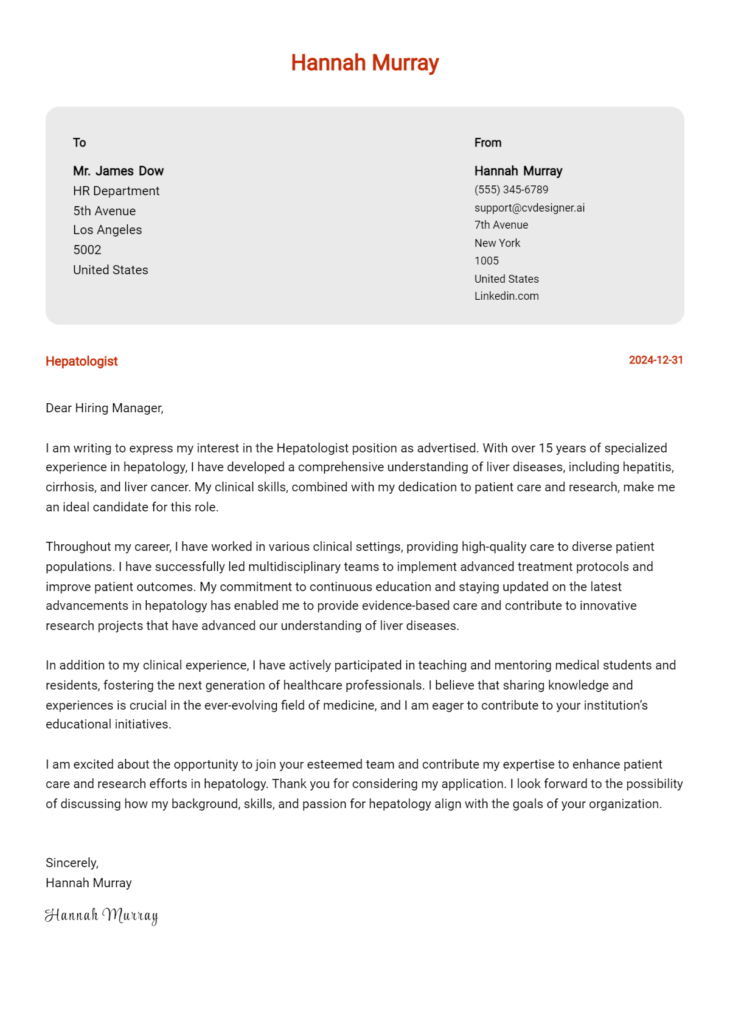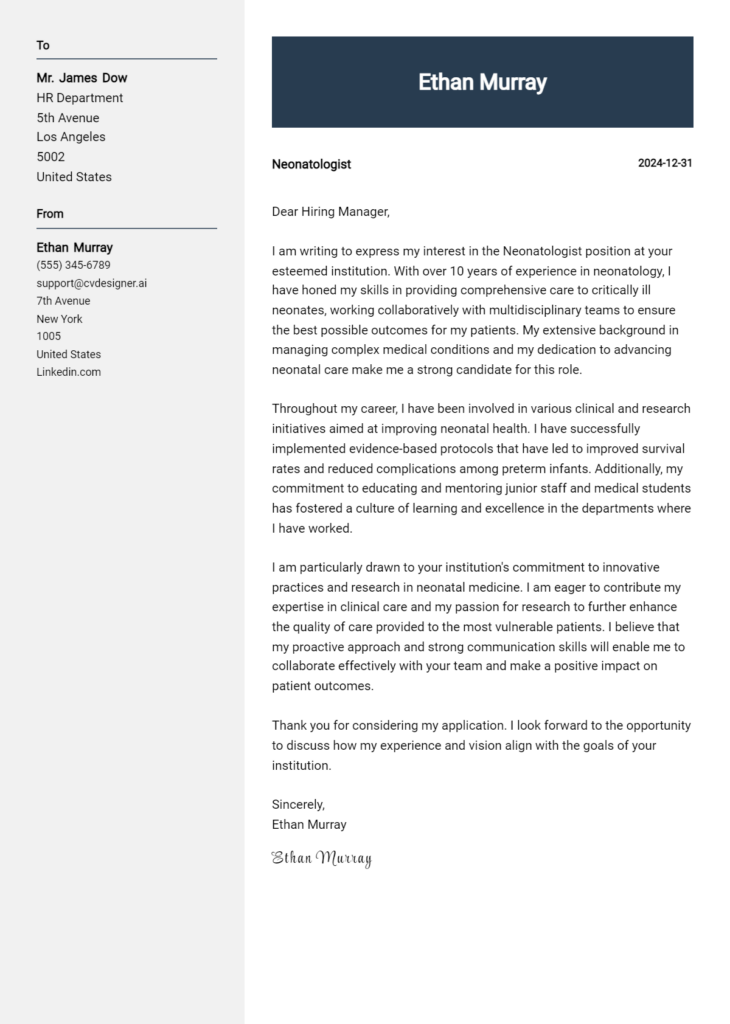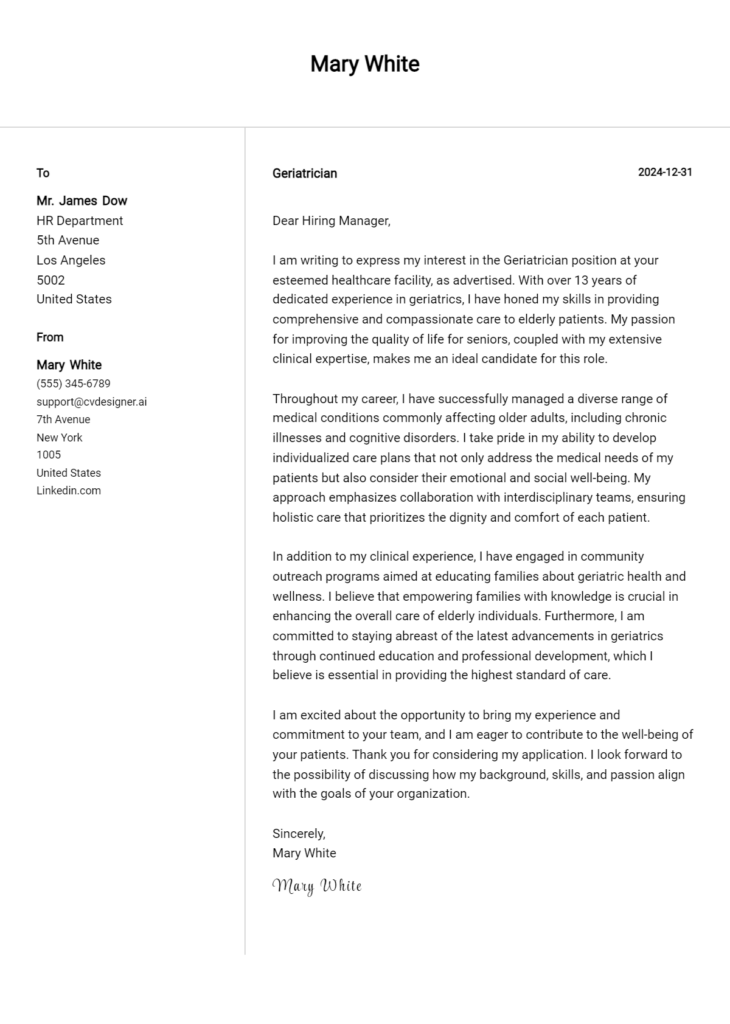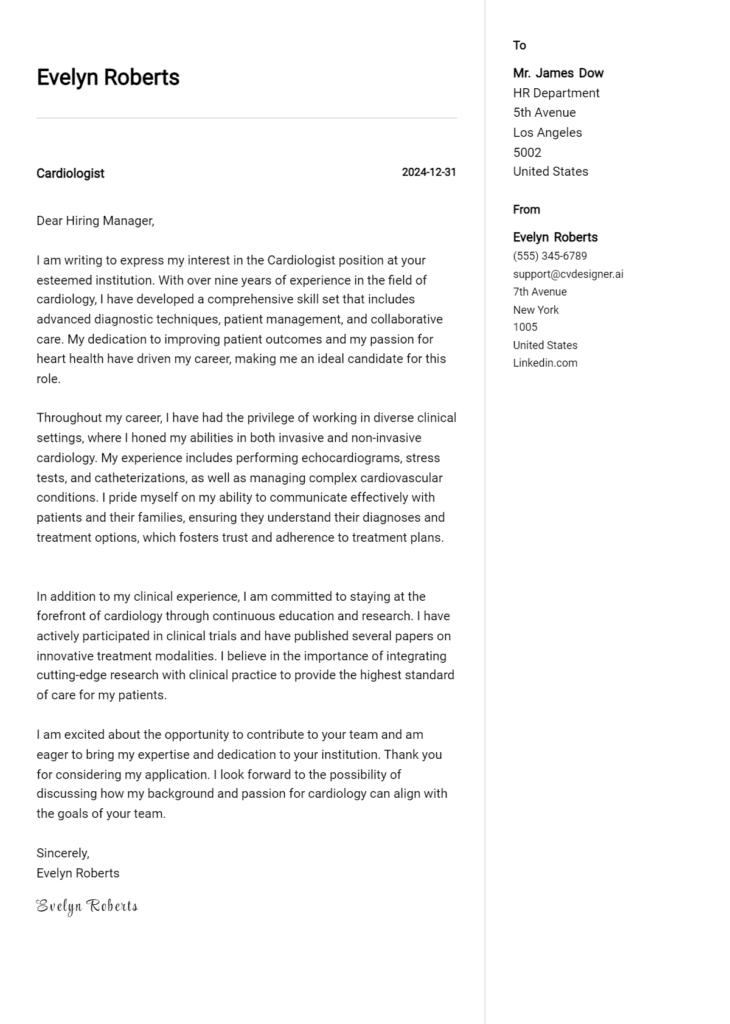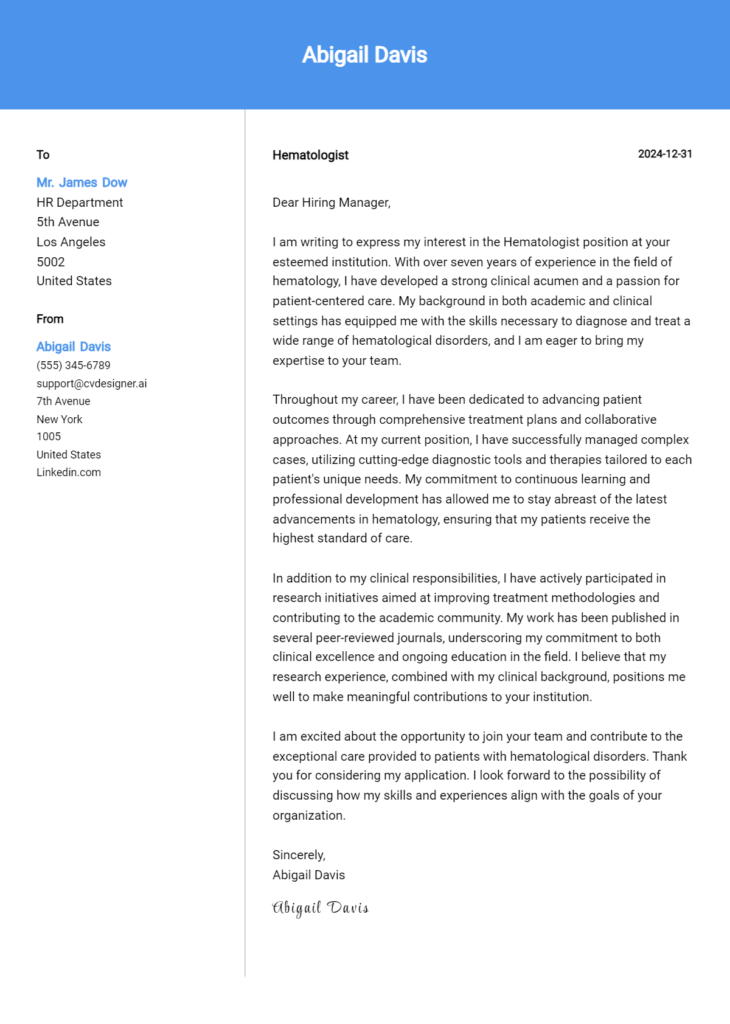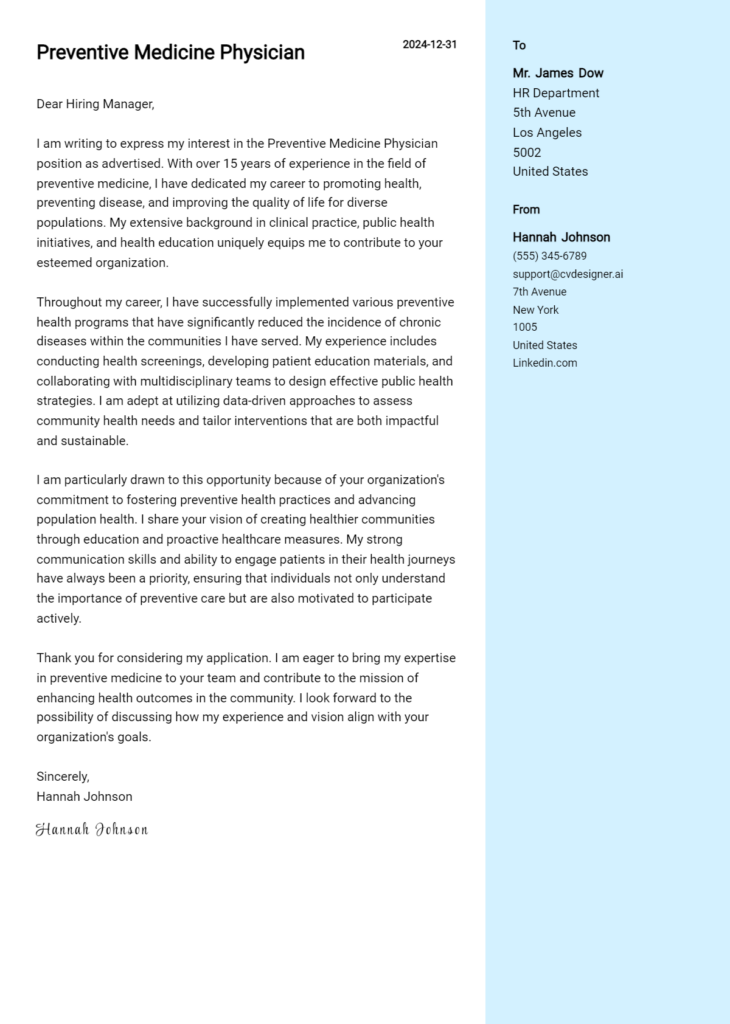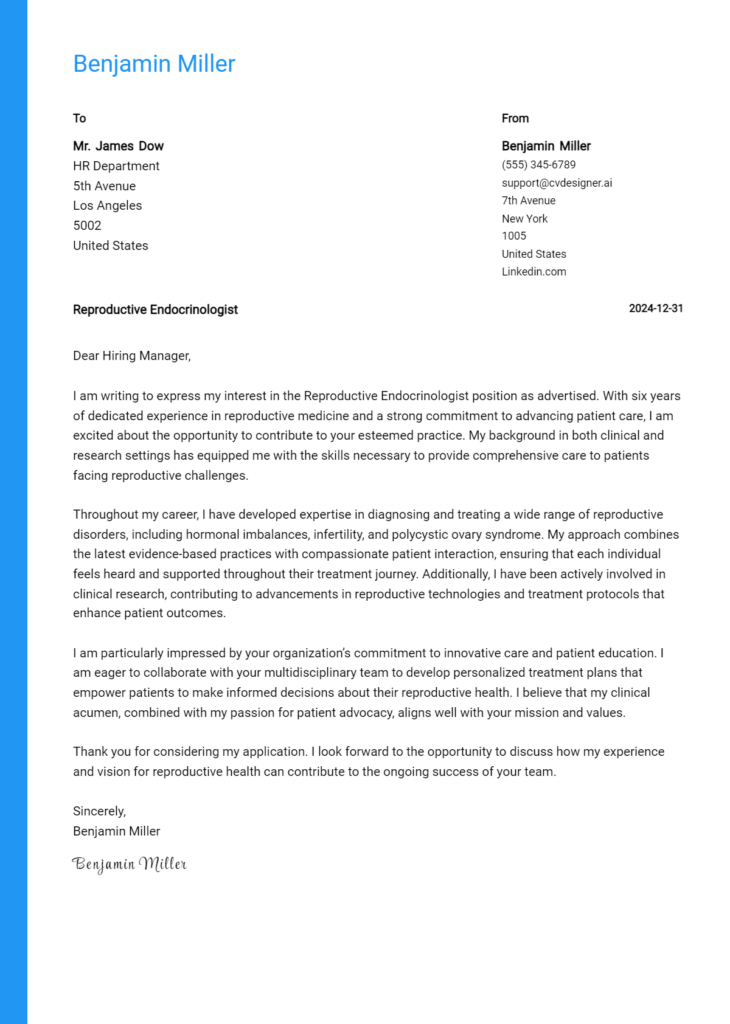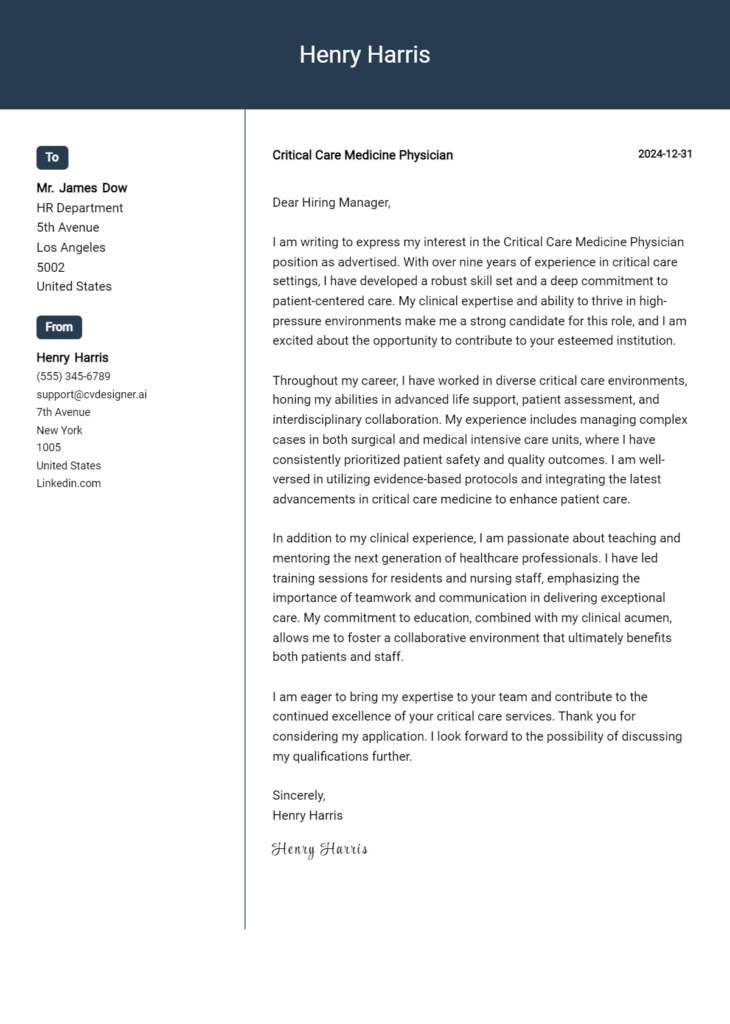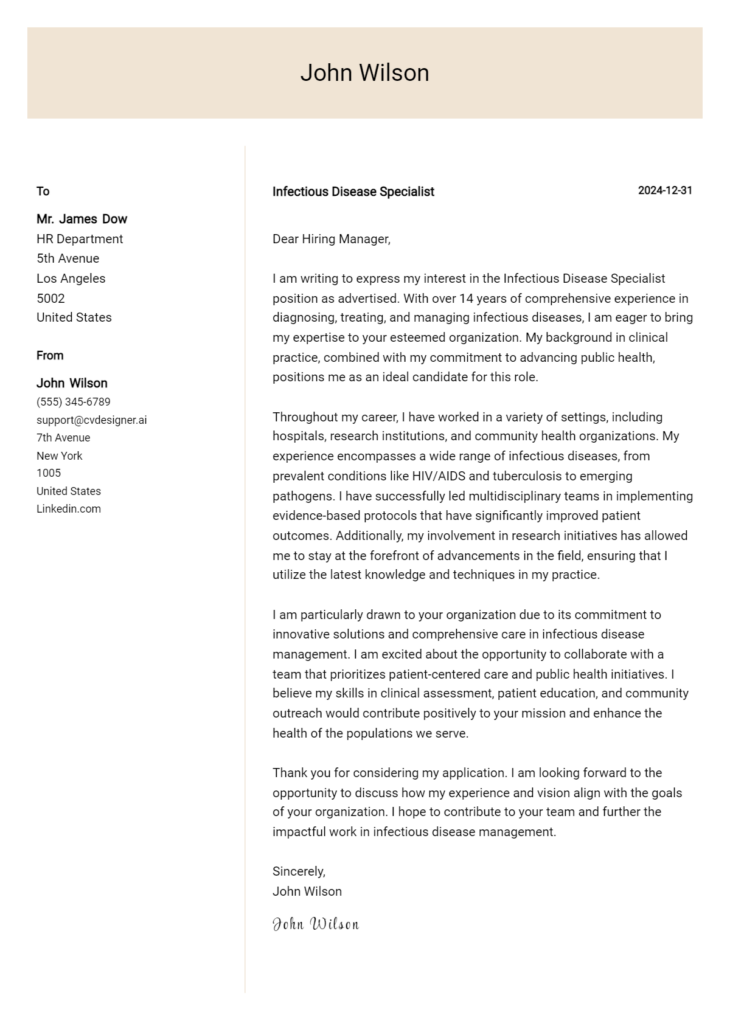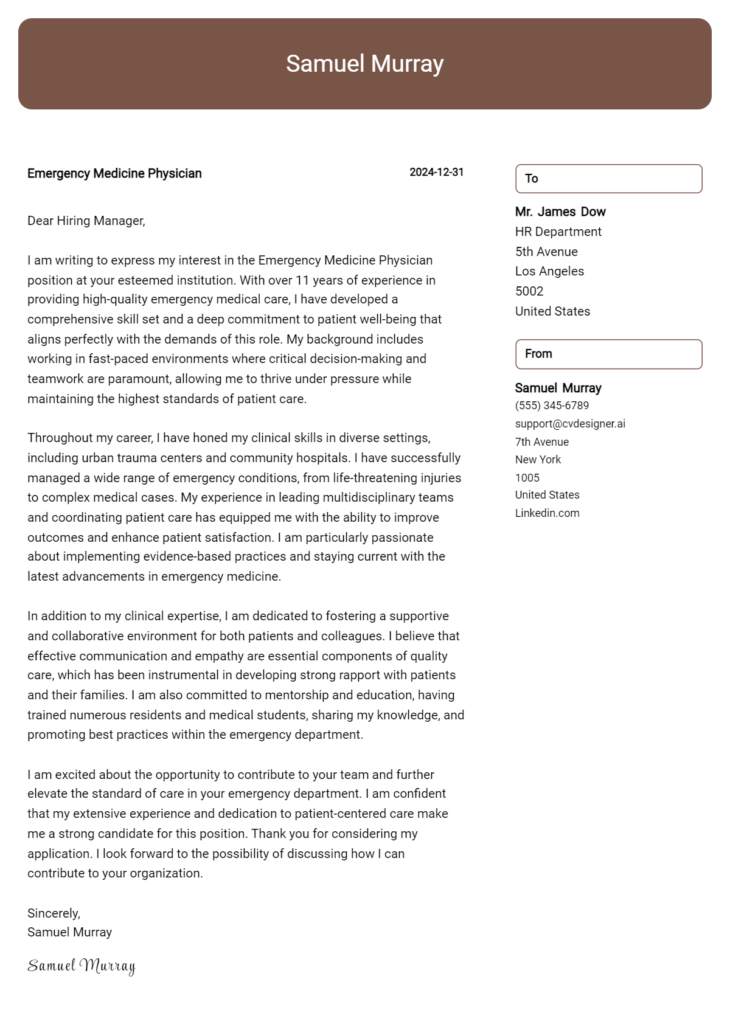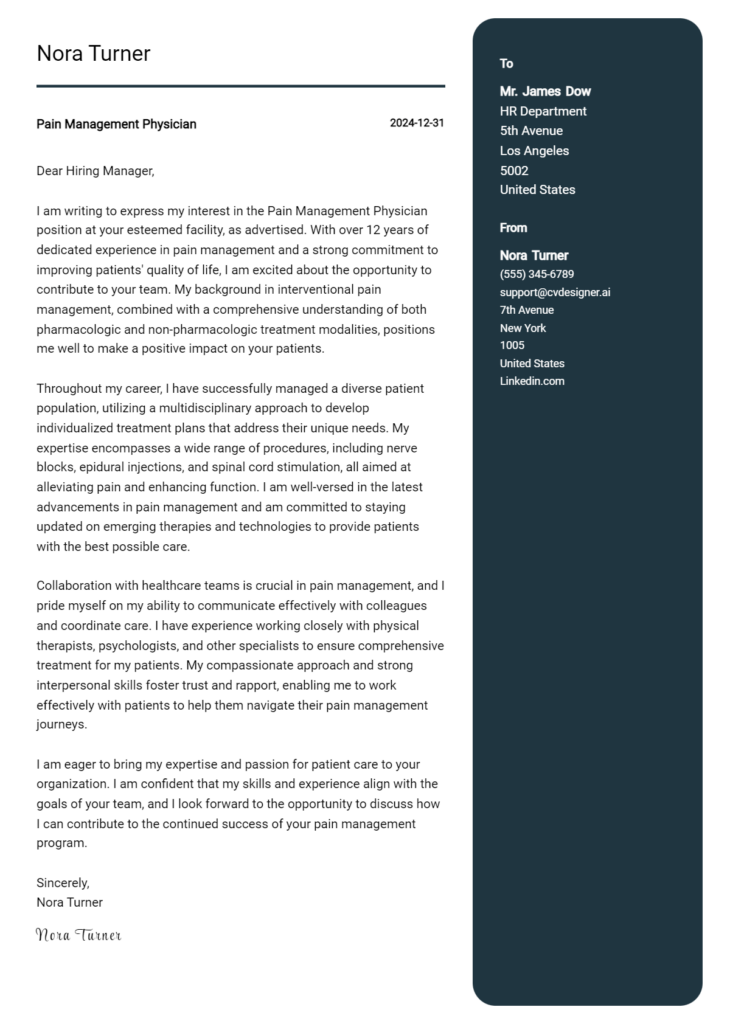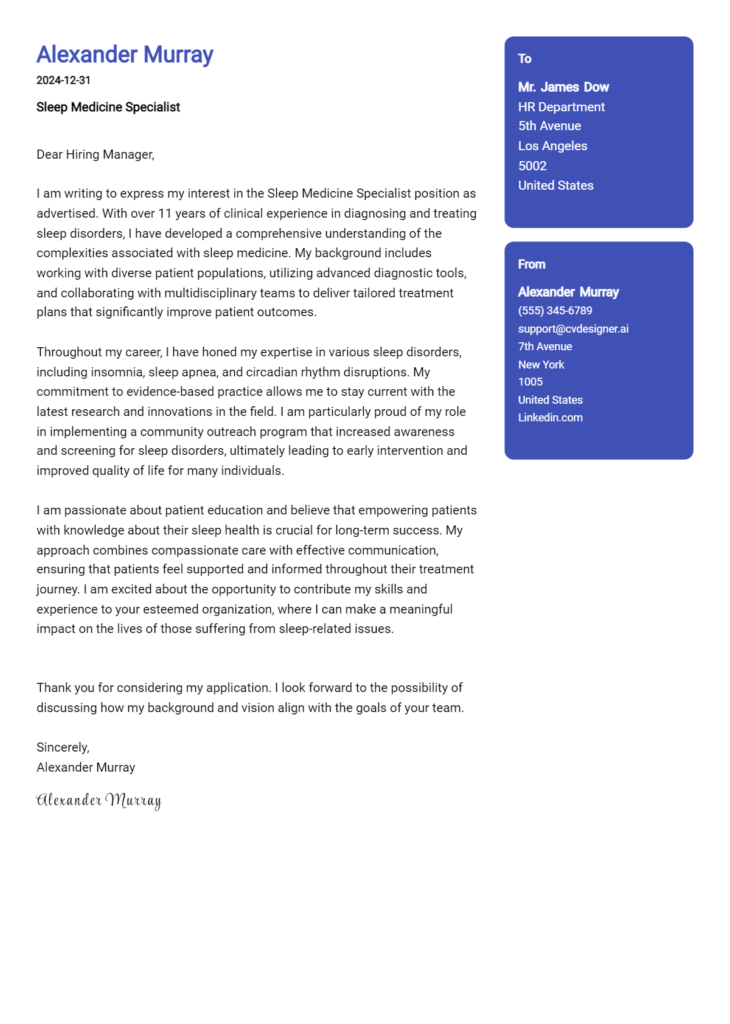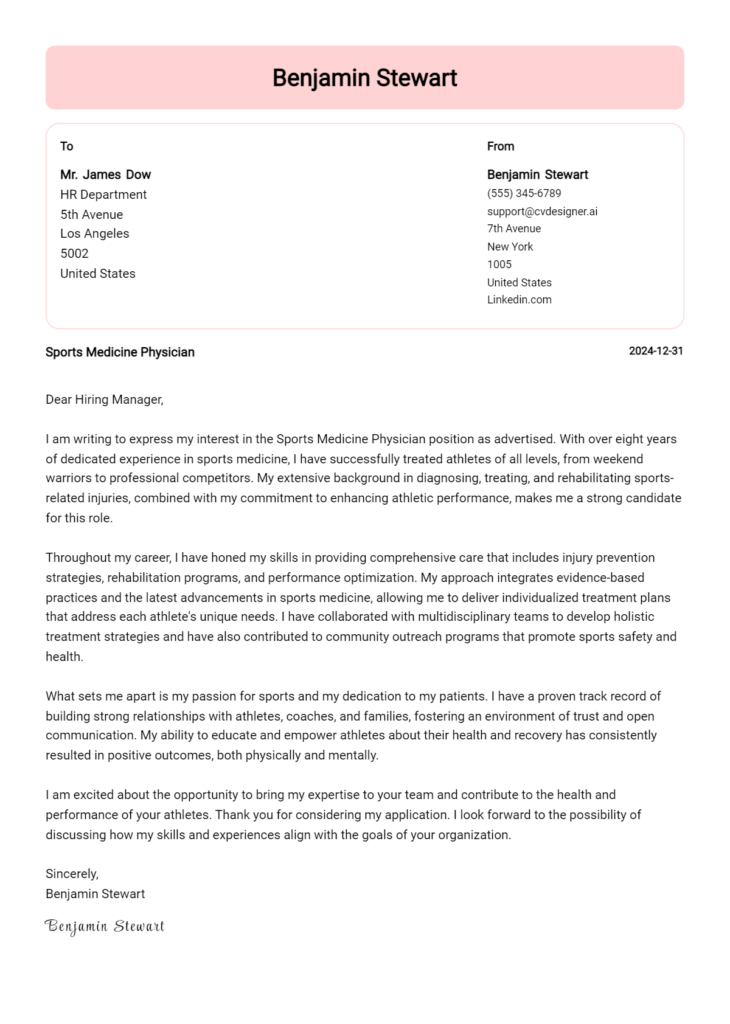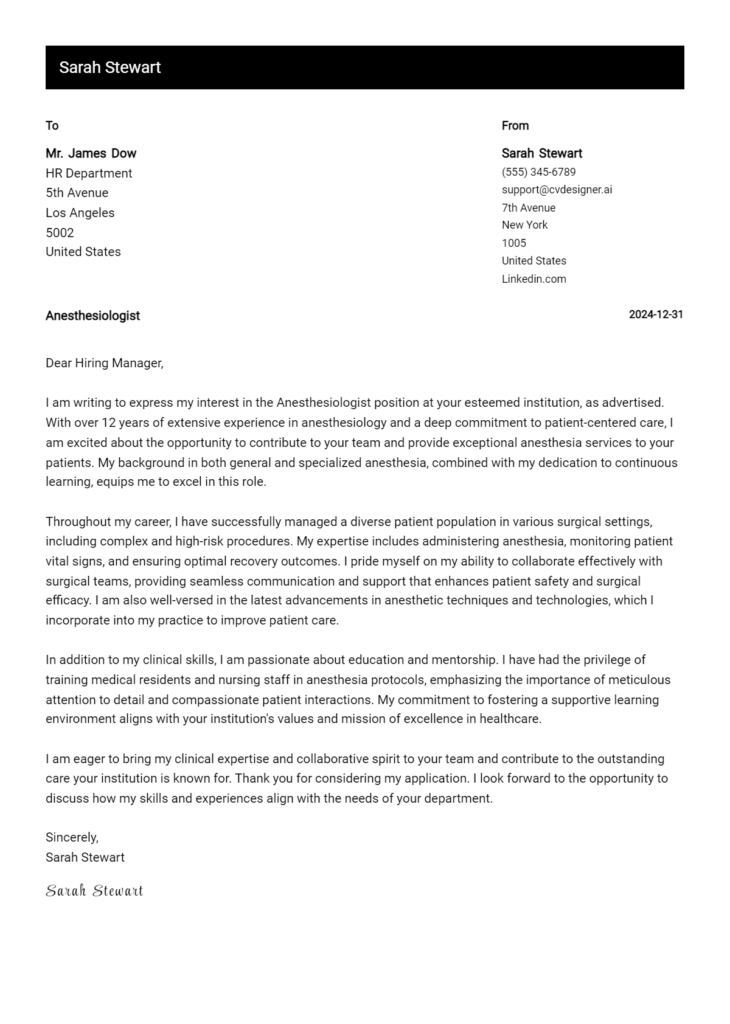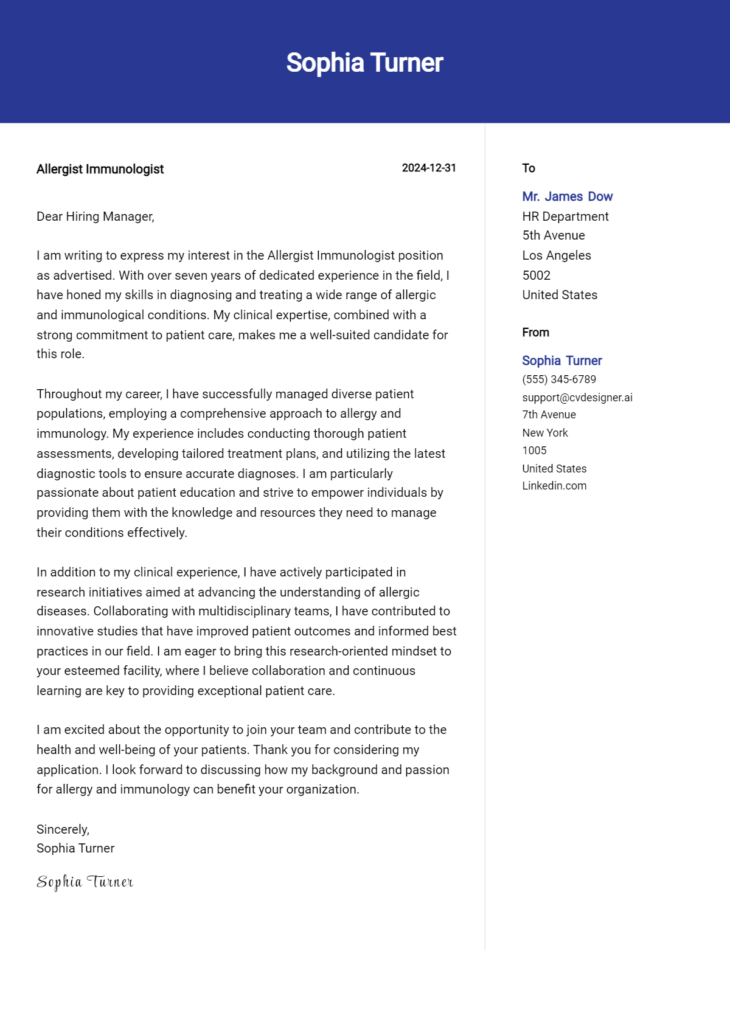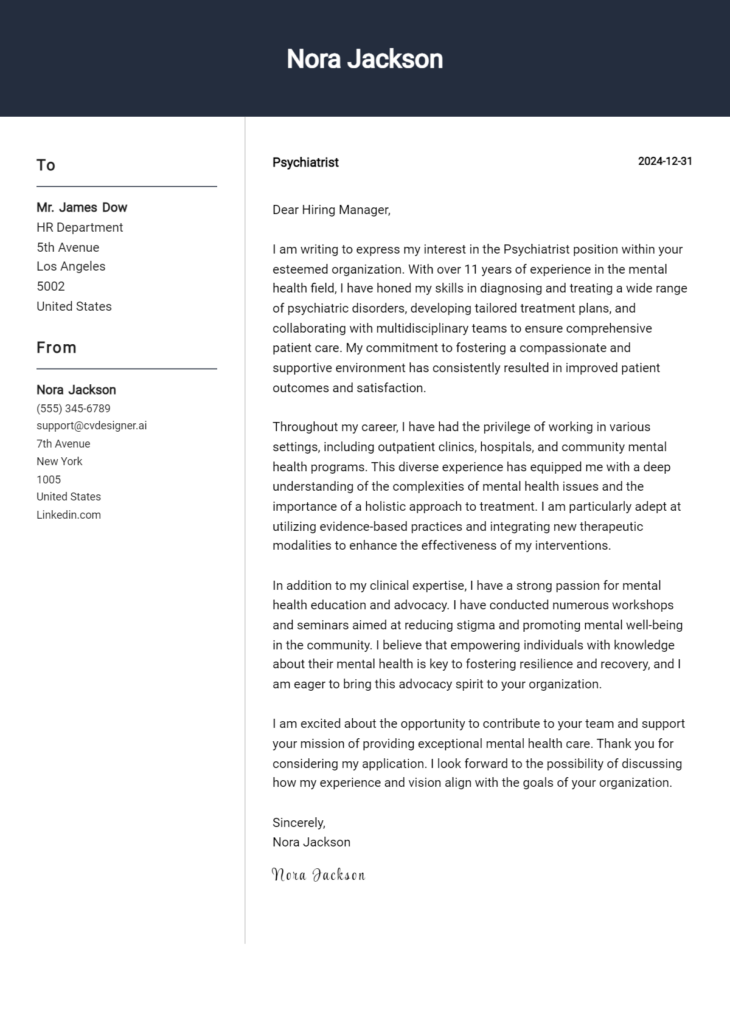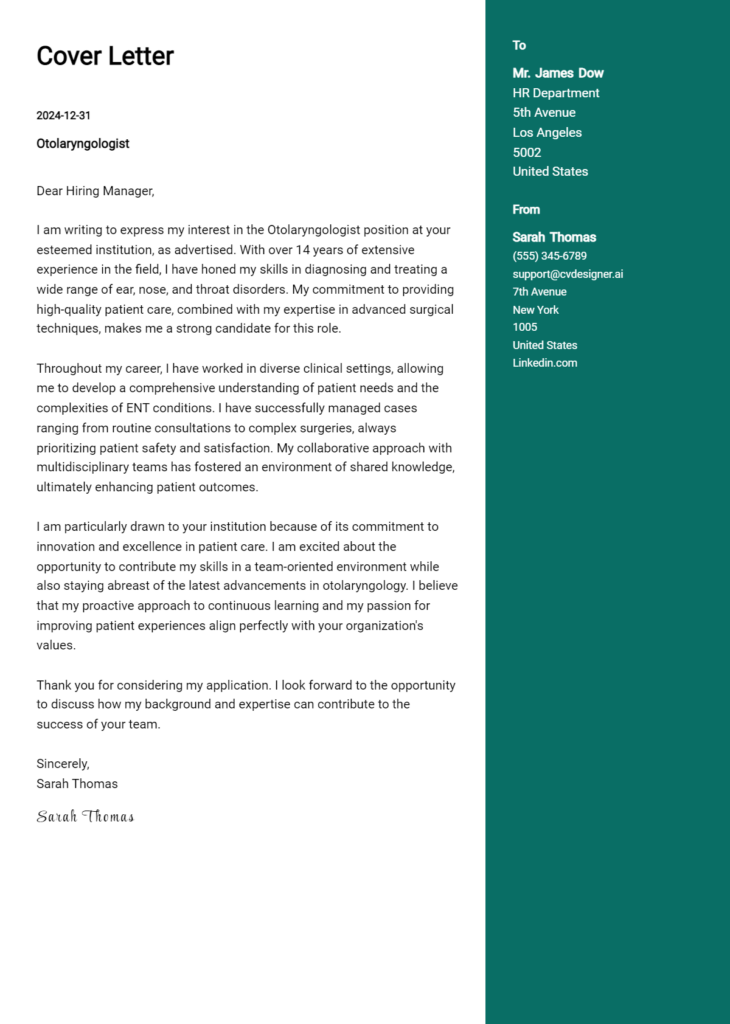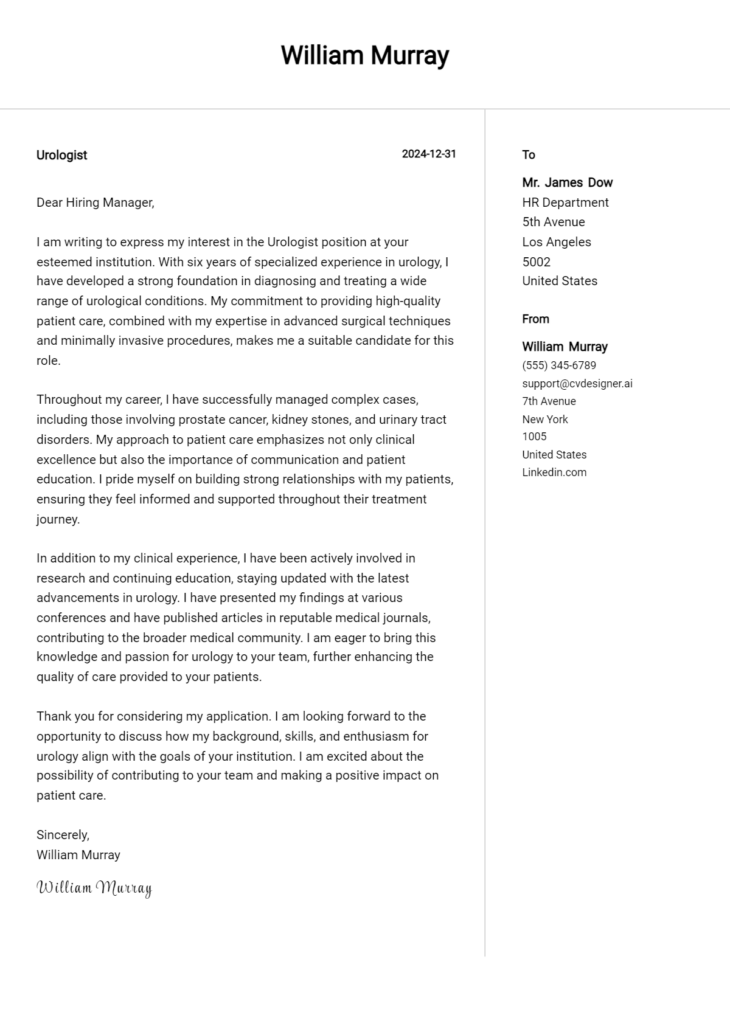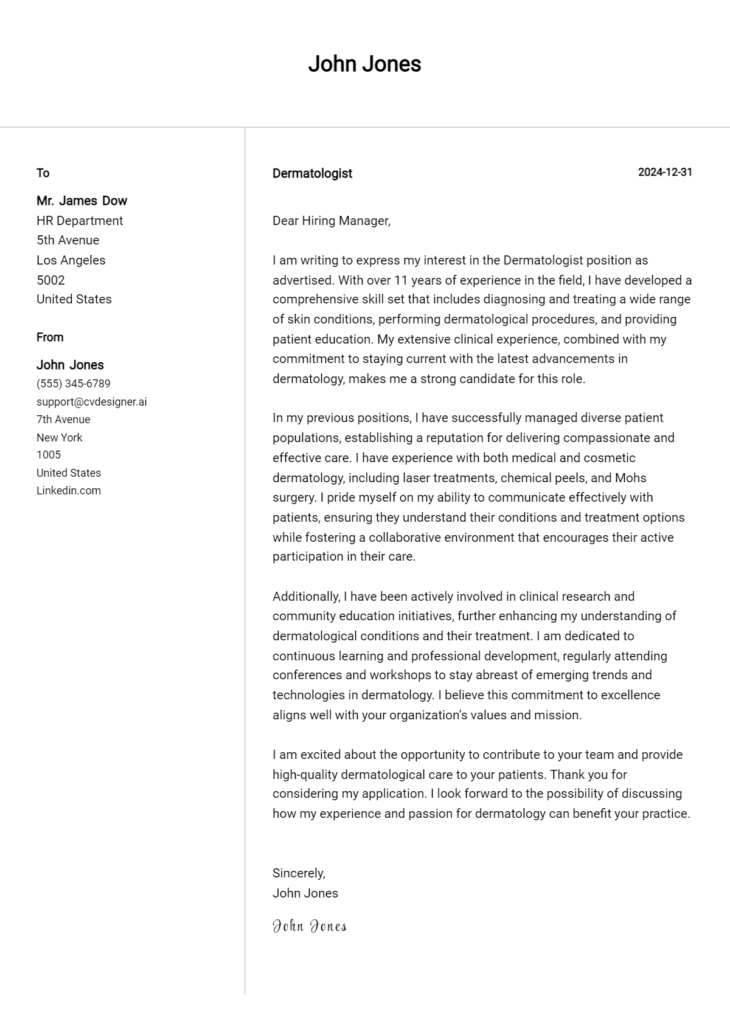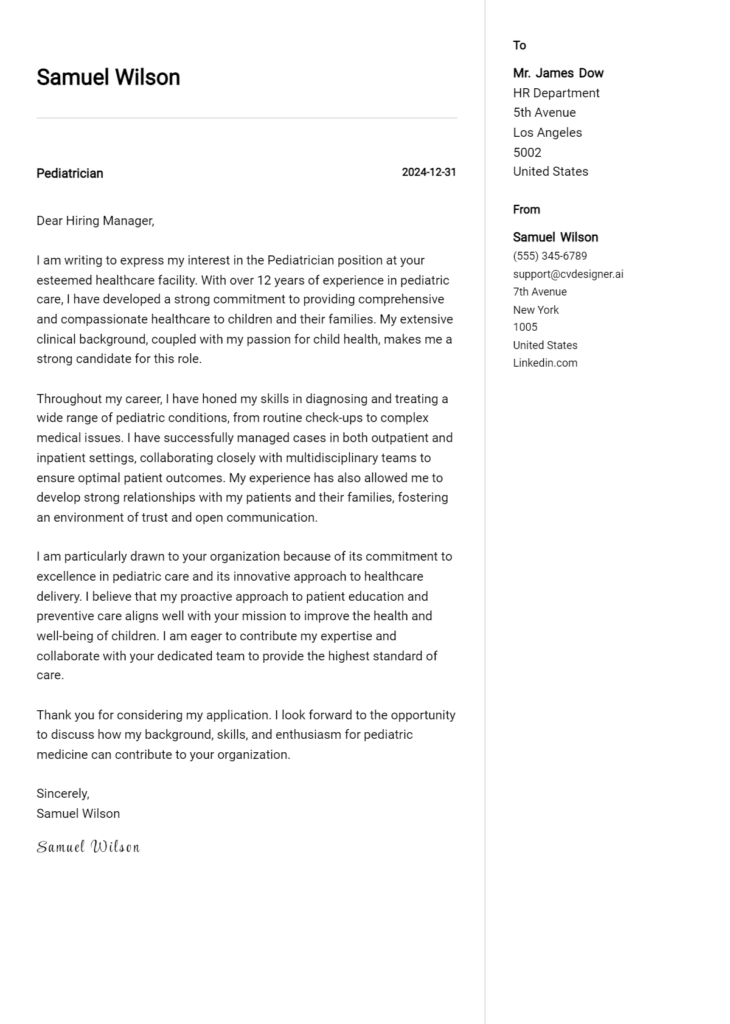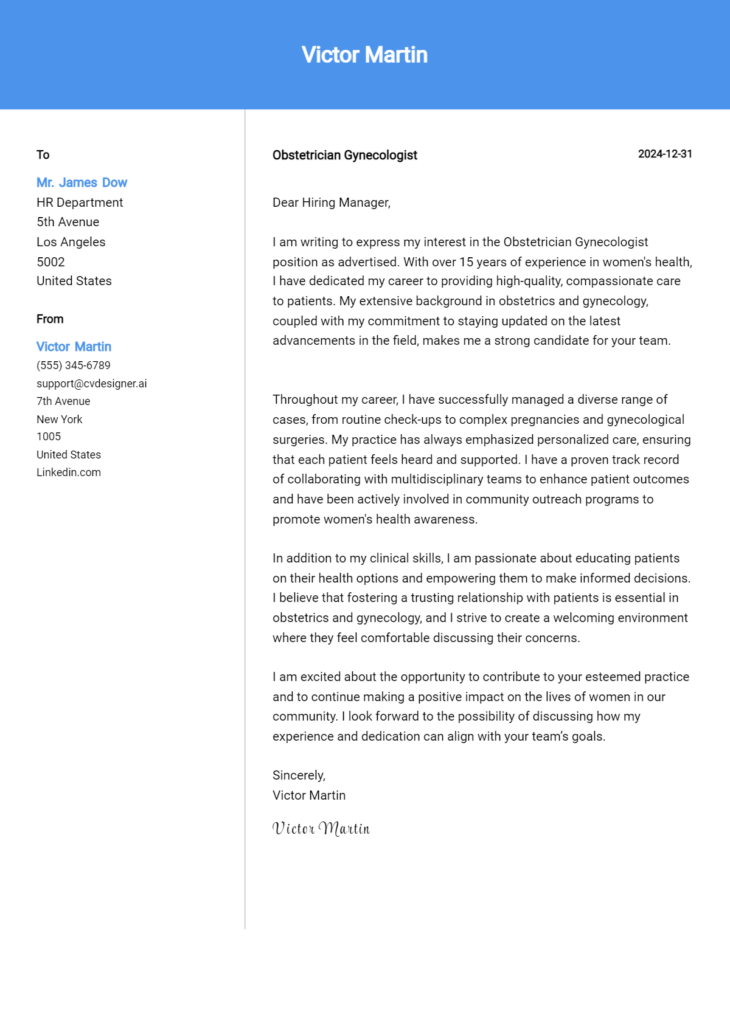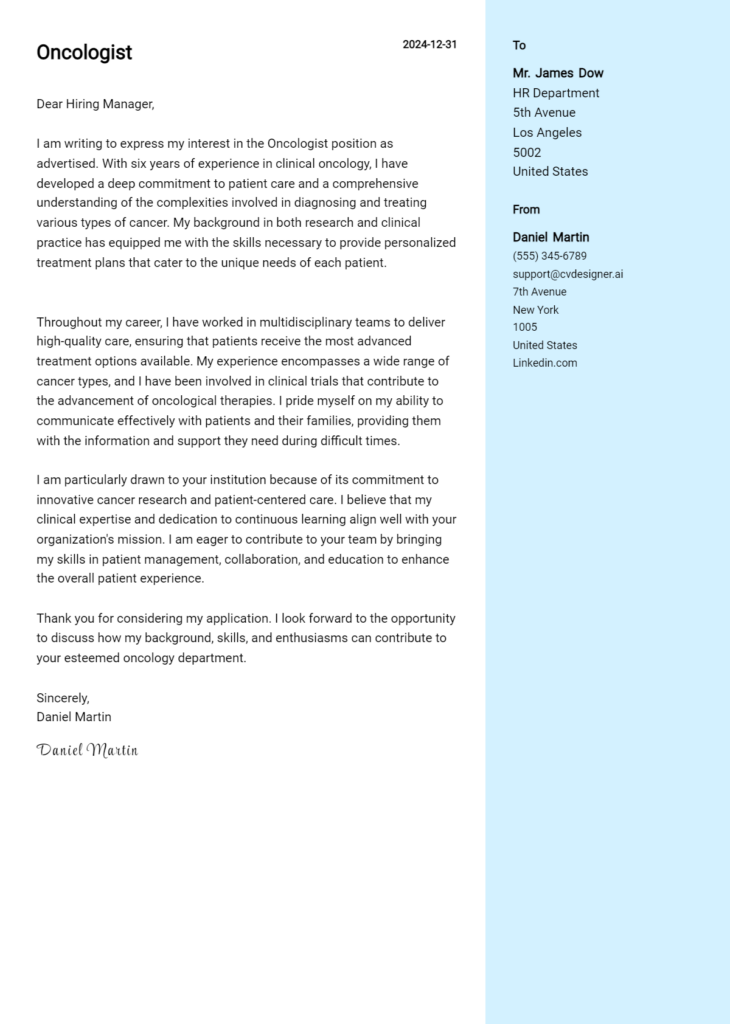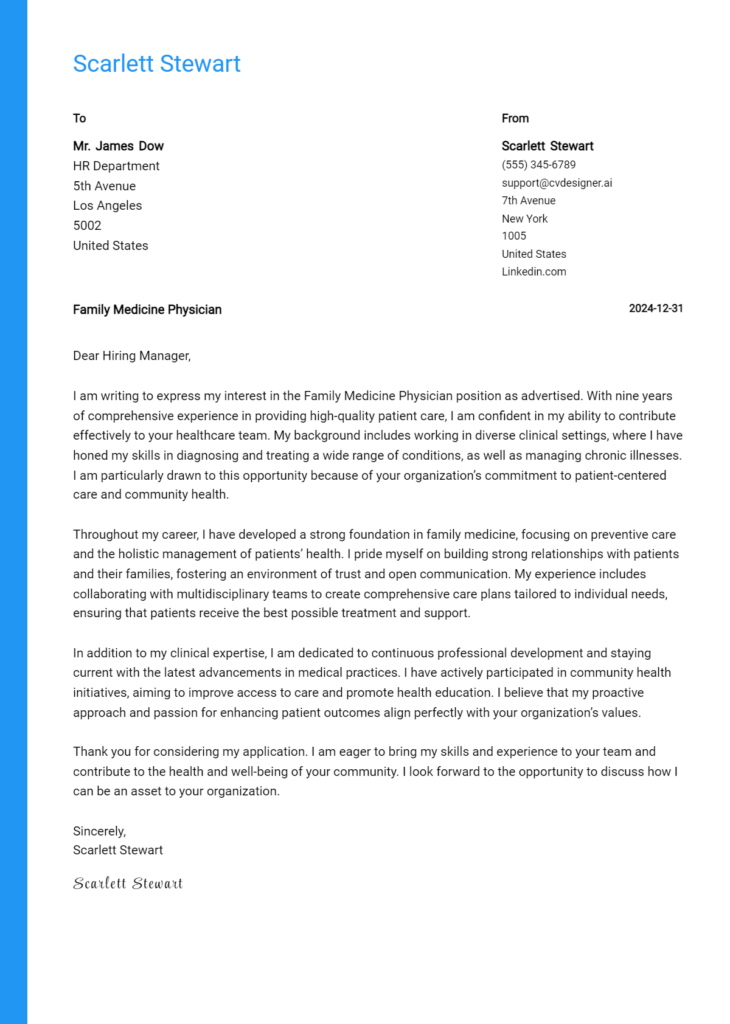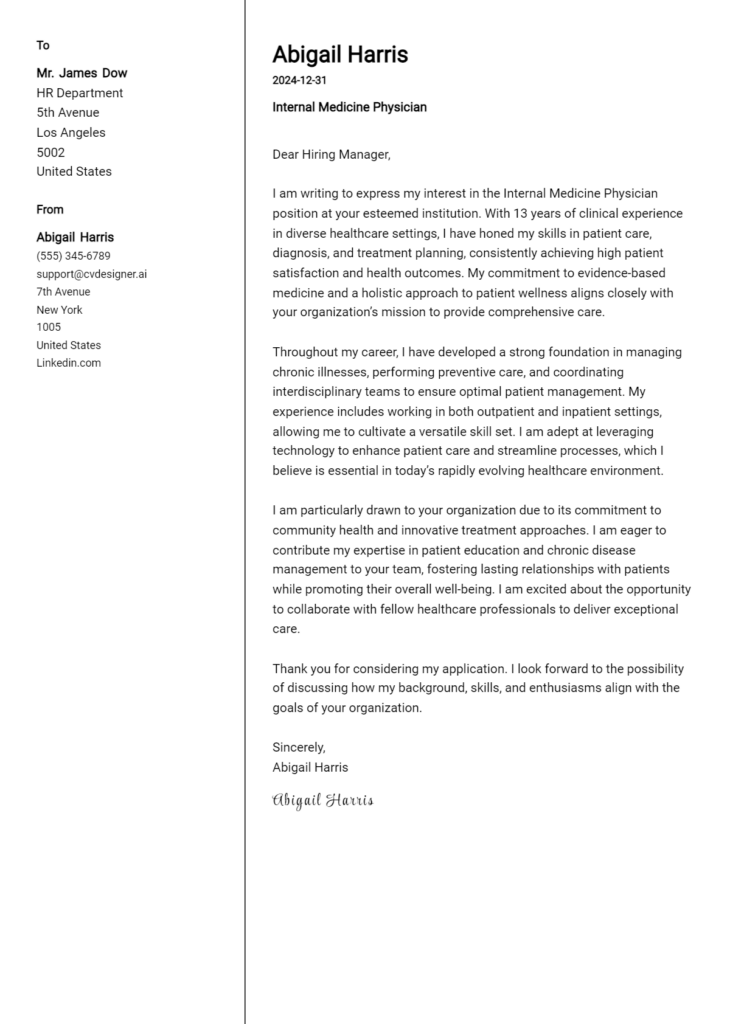Pulmonologist Cover Letter Examples
Explore additional Pulmonologist cover letter samples and guides and see what works for your level of experience or role.
How to Format a Pulmonologist Cover Letter?
Crafting a well-structured cover letter is crucial for a pulmonologist, as it serves as your first opportunity to demonstrate your expertise and dedication to patient care. The format of your cover letter not only showcases your qualifications but also reflects your professionalism and attention to detail—essential attributes in the medical field. A well-organized cover letter can capture the hiring manager's attention and set you apart from other candidates.
In this guide, we will outline how to effectively structure your cover letter, offering insights and pulmonologist-specific examples to help you present a compelling case for your candidacy.
We will focus on the essential components of a professional cover letter, including:
- Cover Letter Header
- Cover Letter Greeting
- Cover Letter Introduction
- Cover Letter Body
- Cover Letter Closing
Each section plays a critical role in showcasing your qualifications and commitment to the field of pulmonology. Let’s delve into each part and explore how to make your pulmonologist cover letter truly stand out.
Importance of the Cover Letter Header for a Pulmonologist
A well-structured cover letter header is crucial for a Pulmonologist as it sets the tone for professionalism and clarity right from the beginning. It should include essential contact information, the date, and the recipient's details to ensure that the letter is easily identifiable and can be promptly directed to the appropriate person. A clear header not only reflects attention to detail but also communicates your organizational skills, which are vital in the medical field. Here are examples of a strong and a weak cover letter header for a Pulmonologist:
Strong Example
Dr. Jane Smith, MD 123 Wellness Drive Health City, ST 12345 (555) 123-4567 jane.smith@email.com March 1, 2024 Dr. John Doe Chief of Pulmonology City Hospital 456 Care Street Health City, ST 12345
Weak Example
Jane S. 123 Street City 3/1/24 To Whom It May Concern,
In the strong example, all the necessary information is included in an organized format, while the weak example lacks essential details and professionalism, making it less effective.
The Importance of the Cover Letter Greeting for a Pulmonologist
The greeting of your cover letter plays a crucial role in setting the tone for the rest of your application. It is the first impression you make on the hiring manager and can significantly impact their perception of your professionalism and attention to detail. A personalized greeting, which addresses the recipient by name, demonstrates your commitment to the application process and shows that you have taken the time to research the organization and its staff. Generic greetings such as "To Whom It May Concern" can come across as impersonal and may suggest a lack of effort. Therefore, if you are unable to find the hiring manager's name, consider reaching out to the organization or checking their website for information.
Here are examples of strong and weak greetings that can be used in a Pulmonologist cover letter:
Strong Greeting Example
Dear Dr. Smith,
Weak Greeting Example
To Whom It May Concern,
The Importance of a Well-Crafted Cover Letter Introduction for a Pulmonologist
A compelling cover letter introduction is crucial for a Pulmonologist seeking employment, as it serves as the first impression to the hiring manager. This introductory paragraph should not only capture attention but also convey genuine interest in the role while highlighting key skills and achievements that make the candidate an ideal fit. A strong introduction sets the tone for the rest of the cover letter and encourages the reader to learn more about the applicant, while a weak introduction may fail to engage and could lead to missed opportunities.
Strong Example
Dear [Hiring Manager's Name], I am excited to apply for the Pulmonologist position at [Hospital/Clinic Name], as I am passionate about advancing respiratory health in our community. With over 10 years of experience in diagnosing and treating complex pulmonary conditions, including asthma and COPD, I have successfully improved patient outcomes through innovative treatment plans and a patient-centered approach. My recent research on the effectiveness of new therapies has been published in prominent medical journals, demonstrating my commitment to evidence-based practice. I am eager to bring my expertise and dedication to your esteemed team.
Weak Example
To whom it may concern, I am applying for the Pulmonologist job at your hospital. I have worked in this field for some time, and I have experience with various lung diseases. I hope you will consider my application and look forward to hearing from you.
Purpose of the Cover Letter Body for a Pulmonologist
The body of a cover letter for a Pulmonologist serves as a critical platform to articulate the candidate's professional journey, emphasizing their specialized skills, relevant experiences, and the unique value they can bring to a healthcare organization. This section should highlight specific projects or accomplishments that demonstrate the candidate's expertise in treating respiratory conditions, collaborating in multidisciplinary teams, and contributing to clinical research. By effectively communicating these elements, the cover letter body not only captures the attention of the hiring committee but also positions the candidate as a strong contender in the field of pulmonary medicine.
Strong Example
Dear Hiring Manager, I am excited to apply for the Pulmonologist position at ABC Hospital. In my previous role at XYZ Medical Center, I successfully led a project that implemented a new protocol for managing patients with chronic obstructive pulmonary disease (COPD). This initiative resulted in a 30% reduction in hospital readmissions over six months. Additionally, I have published research on the efficacy of biologic therapies in asthma management, which has been presented at national conferences. My commitment to patient-centered care, combined with my expertise in advanced pulmonary diagnostics, makes me a valuable asset to your team. Sincerely, John Doe
Weak Example
Dear Hiring Manager, I am interested in the Pulmonologist role at your hospital. I have experience treating patients with lung problems and have worked in various healthcare settings. I believe I can help your team. I am passionate about my work, and I think I would be a good fit. Best, Jane Smith
Importance of Cover Letter Closing for a Pulmonologist
The closing of a cover letter for a Pulmonologist is critical as it serves to summarize qualifications, express enthusiasm for the position, and encourage the hiring manager to take the next steps, such as reviewing the resume or scheduling an interview. A strong closing leaves a lasting impression, while a weak one may fail to convey the candidate's suitability for the role or enthusiasm for the opportunity.
Strong Example
Thank you for considering my application for the Pulmonologist position at [Hospital/Clinic Name]. With over 10 years of specialized experience in diagnosing and managing respiratory disorders, coupled with my commitment to patient care and ongoing education, I am excited about the prospect of contributing to your esteemed team. I look forward to the opportunity to discuss my qualifications further and hope to schedule an interview at your convenience. Please feel free to contact me at [Your Phone Number] or [Your Email]. Thank you once again for your time and consideration.
Weak Example
I hope you look at my resume. I think I’d be a good fit. Let me know if you want to talk. Thanks.
These tips will help candidates craft an effective cover letter for a Pulmonologist position, emphasizing the importance of showcasing technical skills, problem-solving abilities, knowledge of the software development life cycle (SDLC), teamwork, and a passion for continuous learning. A well-structured cover letter not only highlights your qualifications but also reflects your dedication to patient care and collaboration within a healthcare setting.
Tips for Writing a Pulmonologist Cover Letter
Highlight Technical Skills: Clearly outline your key technical skills that are relevant to pulmonology, such as familiarity with diagnostic tools like spirometry, imaging techniques (CT scans, X-rays), and treatment methodologies for respiratory diseases. Use specific examples to illustrate how these skills have enabled you to provide exceptional patient care.
Demonstrate Problem-Solving Abilities: Describe experiences where you've identified complex health issues and developed effective treatment plans. This could involve detailing how you approached a challenging case or collaborated with a multidisciplinary team to address a patient's unique needs. Highlighting your analytical thinking will show potential employers your ability to tackle difficult medical scenarios.
Show Knowledge of SDLC: If applicable, discuss any experience you have with the software development life cycle, especially if it pertains to healthcare technologies or electronic health records (EHR). Mention how your understanding of these systems can improve clinical workflows or enhance patient data management, thereby demonstrating your adaptability in a tech-driven environment.
Emphasize Teamwork: Pulmonology often requires collaboration with other healthcare professionals. Illustrate your experience working within a team, whether it's with nurses, respiratory therapists, or other specialists. Provide examples of successful projects or initiatives that resulted from teamwork, showcasing your ability to communicate effectively and work towards common goals.
Express Passion for Continuous Learning: The medical field is always evolving, so it's crucial to convey your commitment to ongoing education. Mention any relevant certifications, workshops, or conferences you've attended, and discuss how this dedication enhances your practice. This shows potential employers that you are proactive and willing to stay updated with the latest advancements in pulmonology.
By implementing these tips, you can create a compelling cover letter that sets you apart from other candidates. For additional guidance and resources, consider using our cover letter templates or try out our cover letter builder to streamline your writing process.
Common Mistakes to Avoid in a Pulmonologist Cover Letter
Crafting a compelling cover letter is essential for standing out in the competitive field of pulmonology. Avoiding common mistakes can significantly enhance your chances of landing an interview. Here are some frequent pitfalls to watch out for:
Generic Greeting: Using a vague salutation like "To Whom It May Concern" can make your application feel impersonal. Always try to address the letter to a specific person when possible.
Lack of Tailoring: Failing to customize your cover letter for each job application can be detrimental. Research the institution and tailor your skills and experiences to match their specific needs.
Excessive Length: A cover letter should be concise—ideally no longer than one page. Overly lengthy letters can lose the reader's interest. Stick to relevant information and make every sentence count.
Ignoring Formatting Best Practices: Poor formatting can detract from the professionalism of your letter. Ensure you follow appropriate cover letter format guidelines to enhance readability.
Repetitive Content: Simply reiterating your resume in your cover letter is a missed opportunity. Instead, use the letter to highlight key achievements and explain how they relate to the role.
Neglecting Proofreading: Spelling and grammatical errors can create a negative impression. Always proofread your cover letter or have someone else review it to catch any mistakes before submitting.
Failure to Showcase Passion: Not expressing your enthusiasm for pulmonology and the specific role can make your letter forgettable. Make sure to convey your passion for the field and explain why you are interested in the position.
By steering clear of these common mistakes and utilizing effective cover letter examples, you can create a strong impression and improve your chances of success in your pulmonologist job application.
Cover Letter FAQs for Pulmonologist
What should I include in my cover letter as a Pulmonologist?
In your cover letter, clearly state your medical qualifications, including your education, training, and board certifications relevant to pulmonology. Highlight your clinical experience, particularly any specialized skills in areas like critical care, sleep medicine, or interventional pulmonology. Discuss your passion for patient care and any research or publications that demonstrate your commitment to advancing the field. It’s also crucial to express your interest in the specific institution or practice you’re applying to, mentioning any connections you have to their mission or values. Including a brief anecdote about a memorable patient interaction can also personalize your letter and make it memorable.
How can I showcase my skills and experience in my cover letter?
To effectively showcase your skills and experience, use specific examples that illustrate your expertise in pulmonology. Mention any advanced diagnostic techniques you’re proficient in, such as bronchoscopy or pulmonary function testing, and describe situations where these skills improved patient outcomes. If you have experience leading a team or collaborating with multidisciplinary groups, highlight those instances to show your leadership and teamwork abilities. Quantifying achievements, such as improving patient care metrics or participating in clinical trials, can add weight to your claims. Tailoring your examples to align with the job position’s requirements will demonstrate that you’re a strong fit for the role.
How can I make my cover letter stand out from others?
To make your cover letter stand out, personalize it for the specific position and organization you’re applying to. Start with a strong opening that captures attention, perhaps by discussing a unique aspect of your career or your approach to patient care. Use a professional but warm tone throughout the letter. Focus on your unique experiences that differentiate you from other candidates, such as innovative treatment methods you’ve developed or specific patient populations you’ve served. Including testimonials or quotes from colleagues about your work ethic or patient interactions can also add a compelling touch. Lastly, ensure your letter is well-organized and free of errors, as professionalism is key in the medical field.
Should I include references in my cover letter?
Typically, references are not included in a cover letter. Instead, you should mention that references are available upon request, which allows you to keep your cover letter concise and focused on your qualifications. However, if you have a particularly strong recommendation from a respected figure in the field, you might mention it briefly in your cover letter to strengthen your application. It’s more common to include a separate reference list with your resume or application materials. Ensure that your references are aware they may be contacted, and choose individuals who can speak positively about your clinical skills, teamwork, and contributions to the field of pulmonology.
Build your Cover Letter in minutes
Use an AI-powered cover letter builder and have your letter done in 5 minutes. Just select your template and our software will guide you through the process.

